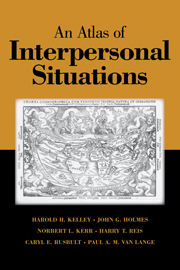Book contents
- Frontmatter
- Contents
- Preface
- PART ONE INTRODUCTION AND THEORY
- PART TWO THE SITUATIONS
- Single-Component Patterns
- Two- and Three-Component Patterns
- Time-Extended Patterns
- Incomplete Information Situations
- N-Person Situations
- Movement from One Situation to Another
- PART THREE EPILOGUE
- References
- Author Index
- Subject Index
PART THREE - EPILOGUE
Published online by Cambridge University Press: 21 October 2009
- Frontmatter
- Contents
- Preface
- PART ONE INTRODUCTION AND THEORY
- PART TWO THE SITUATIONS
- Single-Component Patterns
- Two- and Three-Component Patterns
- Time-Extended Patterns
- Incomplete Information Situations
- N-Person Situations
- Movement from One Situation to Another
- PART THREE EPILOGUE
- References
- Author Index
- Subject Index
Summary
The front of the dust jacket of this book is decorated with an early map of the world, titled Charta Cosmographica, Cum Ventorum Propria Natura Et Operatione (A Cosmographical Map with Special Consideration of the Nature and Operation of the Winds, also reproduced here as Figure E.1). This map was produced by Gemma Frisius in 1544 for inclusion in a very early atlas, Peter Apain's Cosmographicus Liber. Quite apart from its cartographic content, Frisius's map is a beautiful, fanciful work, filled with clouds, heroic figures, strange land and sea creatures, and numerous “windheads” blowing lustily. Noteworthy in this regard are the three grisly windheads at the bottom of the map who express the then-widespread belief that plague was carried by winds from the south.
Of course, compared to a modern world map, Frisius's early map manifests many gross inaccuracies. The continent of North America is reduced to a narrow sliver, to the west of which lies a narrow Pacific Ocean and then a barren Asian mainland. Caribbean islands like Hispanola and Cuba, first discovered by Columbus only about 50 years earlier, are given exaggerated prominence. Distances are often distorted (e.g., between the British Isles and the North American coast). And certain large land masses, like Australia and Japan, are missing altogether.
On the other hand, even this very early map contains much accurate and useful information.
- Type
- Chapter
- Information
- An Atlas of Interpersonal Situations , pp. 449 - 460Publisher: Cambridge University PressPrint publication year: 2003



